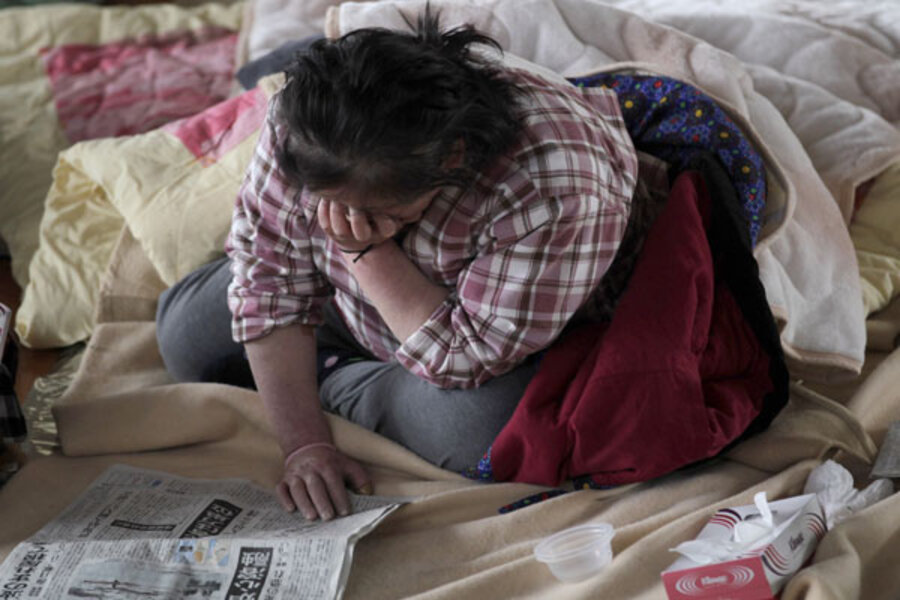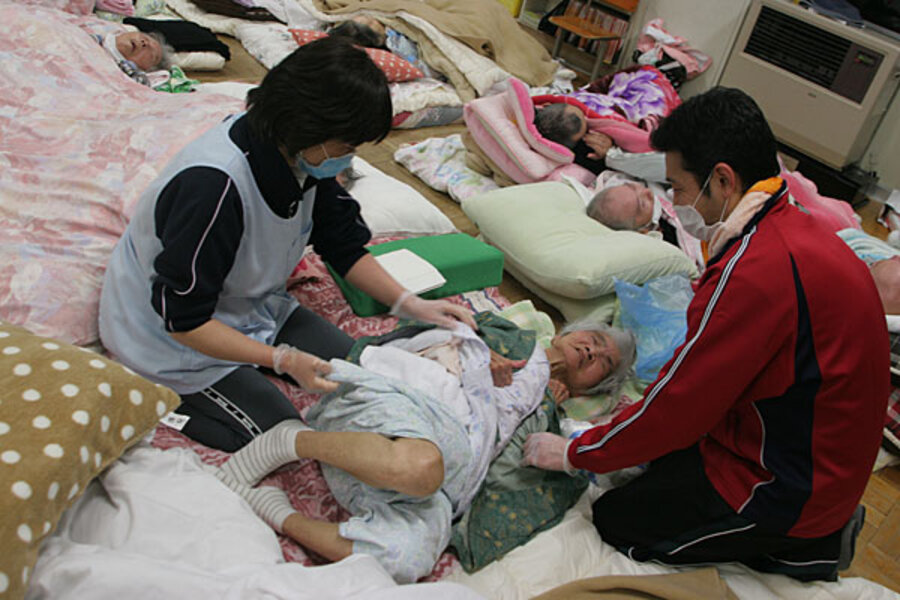Japan's nuclear evacuees wonder if they'll ever see home again
Loading...
| Iwaki, Japan
The first Yoshiko Watanabe heard there might be a problem at the Fukushima Daiichi nuclear power plant where she works as a cleaner was early on Saturday morning. The community radio that the municipal authorities had installed a month earlier in her home came on unexpectedly at around 8 a.m. local time.
“It said we had to go to the town hall to evacuate because there was trouble at reactor No. 1,” she recalls. “I left with just my purse and the clothes I was wearing.”
Now, Mrs. Watanabe and 1,250 others from her home town of Narahama are sleeping on the floor of classrooms in a junior school here, 20 kilometers (12.5 miles) away, unsure if they will ever live in their homes again.
“Sometimes I wonder, but I try not to think like that,” she says, her eyes moist, standing in the school entry hall amid piles of cartons of food, clothes, blankets, and water.
More than 200,000 evacuated
The Narahama evacuees huddled in blankets on the floor, including a score of patients from an old peoples’ home, are among the more than 200,000 residents ordered out of an area within a 20 kilometer (12.5 mile) radius of the Daiichi facility, where two reactors have gone into partial meltdown, according to the government, in the wake of Friday’s massive offshore earthquake and subsequent tsunami.
Their mood is one of shock and resignation.
A third of Narahama families have someone employed at the nuclear power plant says Makoto Mizenoya, whose mother works in the canteen there. “We never ever expected anything to go wrong,” she says.
Caught off guard
The Narahama authorities had no plan to cope with such a disaster says Hiroshi Suzuki, a weary local official and community organizer whose stubbled chin betrays the fact that he has not been home since the tsunami struck.
“We never expected anything to happen,” he explains. “We have lived and worked with the plant all our lives. We got used to it.”
Mr. Suzuki and other city government officials organized local buses to shuttle the town’s residents the 12.5 miles to Iwaki. “It took hours because the roads were so crowded,” he says.
The evacuation has been complicated by the fragile state of telephone lines in the earthquake-struck zone, which stretches more than 100 miles along Japan’s East coast, and by the closure of the region’s main North-South highway.
Help on the way
Other Japanese provinces have been providing help, though.
On Sunday evening, volunteers here formed a chain to unload boxes of aid from trucks that had arrived from Niigata Province, home to the Kashiwazaki nuclear plant that itself suffered a serious accident after an earthquake in 2007. At that time, the city of Narahama sent aid for people in Niigata Province. Now the favor is being returned.
The evacuees here are being fed and sheltered, but some complain that they have been offered no medical help and they are angry with the government.
“The government says the radiation leaks are not harmful to humans, but I have heard that 80 people have been found to be contaminated,” says Mr. Mizenoya’s mother, who declined to give her name because she works at the Daiichi plant.
“Nobody has tested us and I am really afraid that I have been contaminated,” she adds. “There is a gap between what the government says and reality, and I am confused.”
Indeed, the government maintains that the radiation leaks are not harmful to humans. Yet, at least 22 people are known to have been exposed to radiation and are being treated in hospital, and Japan’s nuclear and industrial safety agency said that as many as 160 people may have been exposed.
“We really can’t afford to think about that sort of thing,” says Mr. Mizenoya. “All we can do is just get on with things.”






